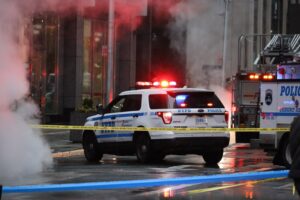I’m back from Las Vegas, and I’ve got some thoughts on how the industry’s trade show comeback went down.
Facing down a pandemic and continuing supply shortages, SHOT Show returned to the Venetian Expo Center. I was there and I have a bit to say about what I saw. I wanted to give you all early access before it goes live tomorrow.
Plus, outdoor writer Gabby Hoffman joins the podcast to talk about her experience at the show and what some of the top Republican governors told gun makers during their forum.
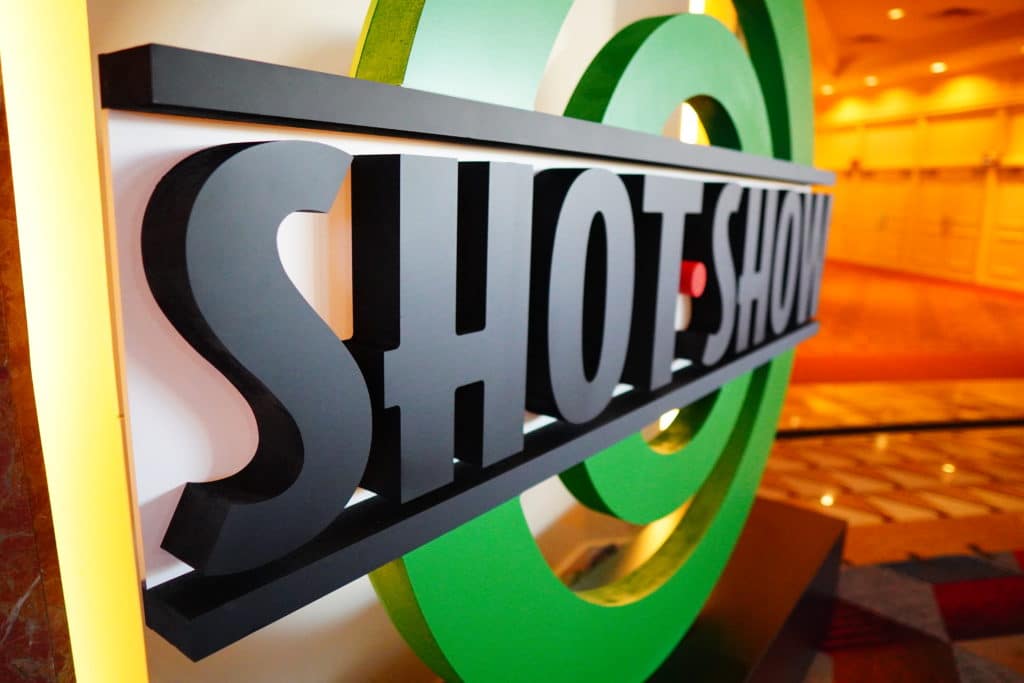
Feature: SHOT Show in the Time of Coronavirus [Member Early Access]
By Stephen Gutowski
LAS VEGAS, NEVADA — Guns, porn, and concrete.
That’s what you can expect to find in the Nevada desert on the third week of most Januarys. But it’s been a while since we’ve had a January like most.
Last year the firearms, adult, and concrete industries canceled their conventions. This year, SHOT Show and the World of Concrete pushed through omicron concerns while the AVN Show pulled out back in September.
There’s a lot to be said about the specifics of this year’s SHOT, and we’ll get to that, but it’s impossible to separate the event from the pandemic in which it occurred.
While not the first conference to reopen since March 2020, it is one of the first major gun gatherings as the NRA has been forced to cancel their own annual meeting two years in a row. How well SHOT plays out will surely be examined by those planning big indoor firearms events moving forward. With NSSF telling me they had over 40,000 attendees and no reports of a superspreader event (though it’s likely harder to notice something like that given how much community spread there is right now), it appears to have been a success.
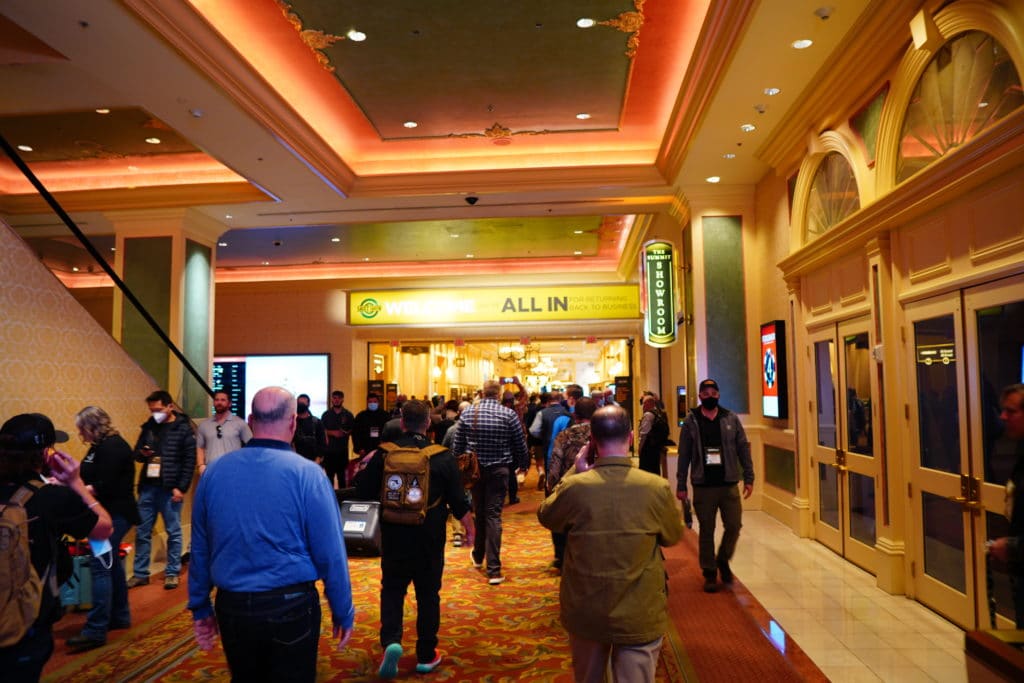
That’s not to say things felt like normal.
There’s a euphemism for viral sicknesses that get passed around at the conference each year. It’s called “SHOT Show crud.” In years past, that was probably the flu or the common cold. Obviously, the risk this year is it would be coronavirus.
The National Shooting Sports Foundation was not unprepared, though. They made all the mitigation efforts you’d expect. Masks were required by the state, and surgical masks were provided all over the convention center alongside hand sanitizer. Part of the show was also outside.
As far as big events go, people at SHOT wore their masks as often as any other one I’ve been to since this all started. Most people wore them most of the time.
That helped alleviate some of my own concerns over the virus. But, obviously, even if you’re trying to take every added precaution, it’s not really possible to wear your mask 100 percent of the time or eliminate every risk. I’m triple vaccinated, so my risk of serious illness is minimal even if I do catch the virus.
But, my contributing writer Jake Fogleman is also triple vaccinated, and he had to cancel his trip to show after coming down with covid. He also happens to be younger and in better shape than I am. He’s doing much better now, but that certainly brought the virus back to the front of my mind as I boarded a five-hour flight to spend a week in a convention center with 40,000 strangers.
In the end, I figured my personal risk was probably lower than it might feel. I can’t just stay at home forever even if I get why Sig, Ruger, or Springfield felt the risk of even a moderate outbreak among employees they sent wasn’t worth it.
I’m back in Virginia and feeling just fine. So, I guess my calculation was correct. Who knows?
None of this is terribly unique to SHOT Show. It’s happened at lots of conferences and trade shows across industries and ideologies. The Consumer Electronics Show saw even more big companies pull out and even further depressed attendance just the week before SHOT. And attendees at the Conservative Political Action Conference long joked about the prevalence of the “CPAC plague.” Well, at least they did before CPAC became the site of one of the first covid outbreaks in 2020.
Conference contagions are nothing new (oddly, I’ve still never caught one). And debates over whether trade shows are worth the risk or cost of attendance, especially for bigger brands, are practically a new normal at this point. I’m not sure I can provide much further insight there.
So, then, what did SHOT have to offer in the way of insight into where the gun industry is at right now?
Well, not really all that much. Attendance was down, but not to a level that’s below what you might expect given everything going on. And there wasn’t a whole lot in terms of prominent product trends either.
It seemed like most companies were just focused more on moving the guns they already make.
There was one very noticeable trend at Range Day, though. And that was the lack of ammo. Sure, there was still enough for everyone to try out each gun. But, what used to be a 15 or 30 round demo in the past was often paired down to five rounds this year.
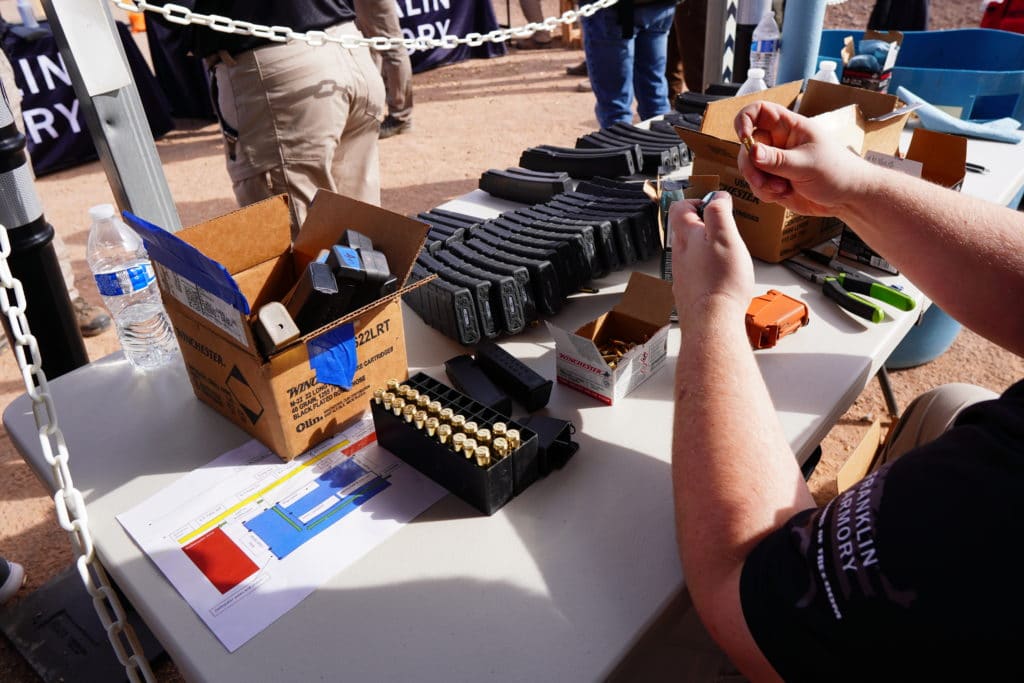
There were new guns, of course. And even new calibers of ammunition. The .30 Super Carry made a bit of a splash as a smaller but more modern competitor to the 9mm.
I didn’t get to shoot any of the .30 Super Carry’s at Range Day. But, I did get to handle a Smith & Wesson Shield and a Shield EZ in the caliber. The idea is the cartridge is nearly as effective as the popular 9mm, but it enables more rounds to be carried in the same package.
I recommend keeping your eye on some of the YouTube review channels or gun magazines for details on how the round performs in practice, but I’m a bit skeptical about how much of a splash it’ll make in the current market. After all, the latest carry guns can all fit 15 or more 9mm rounds into tiny packages. How much of an advantage is an extra round or two at this point?
But maybe it can gain some ground just by having actual stock available. Everybody wants 9mm right now. Perhaps it’ll be easier to find .30 Super Carry at more reasonable prices? I guess we’ll have to wait and see if the ammo can make it to market before production of everything else has caught up to demand.
There was also some interesting “smart gun” tech at the show. I don’t just mean guns with integrated and personalized locks, though there was a non-functioning prototype of that sort there. I think the definition of “smart gun” has been far-too-limited.
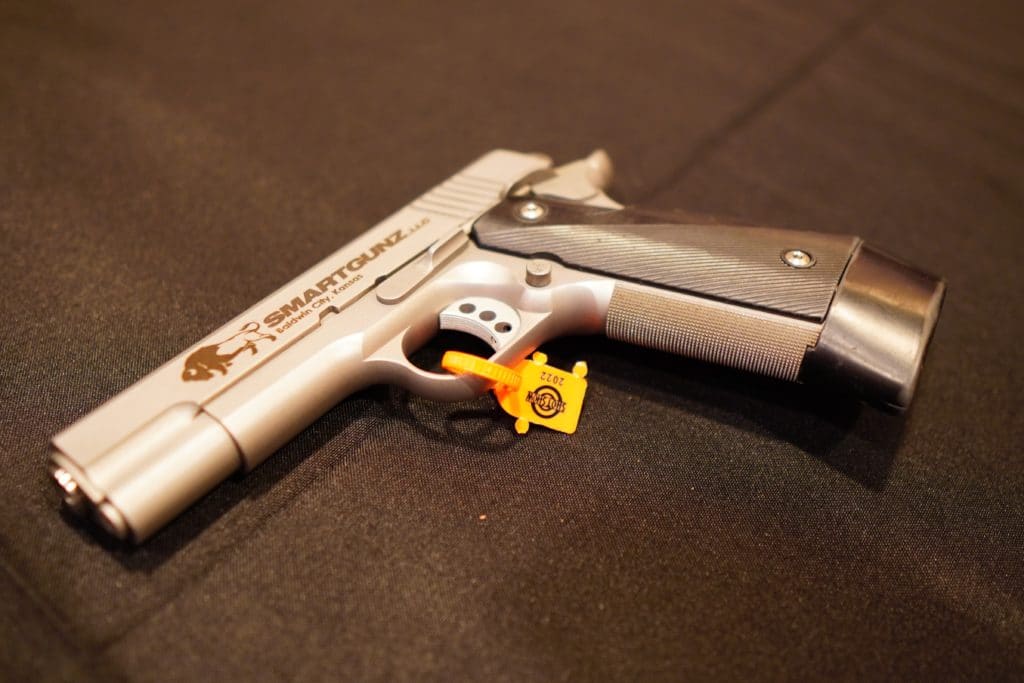
For instance, Mantis X makes a computer that you strap to your gun, which tracks your movements as you shoot or do dry-fire practice in order to give you tips on improving your technique. They pair that tech with an app that gives you drills and tracks where your shots are hitting. They even have a new system for an AR that allows you to dry fire multiple shots without resetting the trigger each time.
Magpul is also getting into the smart game with a new optic mounting system that’s straight out of a video game. It can display how many rounds are left in your magazine, how far away your target is, and calculate bullet drop.
There were some traditional guns that piqued my interest as well.
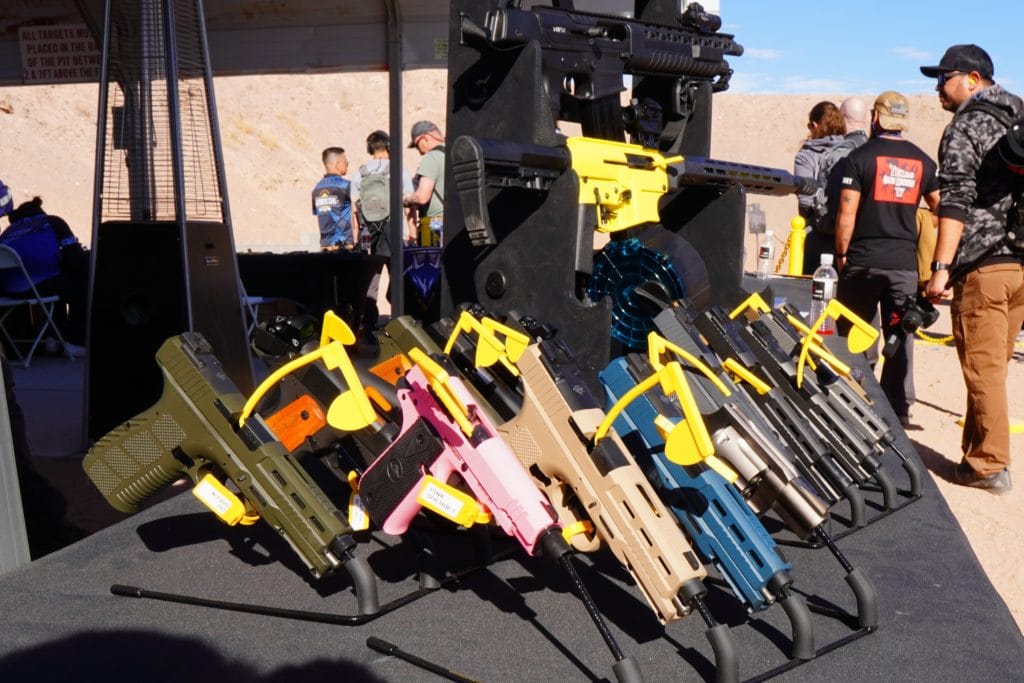
Rock Island Armory is also getting into the 9mm semi-automatic striker-fired handgun game with their own offering, the STK 100. Instead of a polymer lower, they’re using an aluminum one. The handful of shots I put through it felt nice, and the MSRP of $599 could be competitive. It seems like they may be moving from making 1911s to making their own handgun designs–something that Kimber pulled off at a higher price point.
Finally, I also got to actually shoot the Laugo Alien! I think the hype is real. The non-tilting barrel combined with the stationary top strap does appear to reduce barrel flip and increase accuracy.
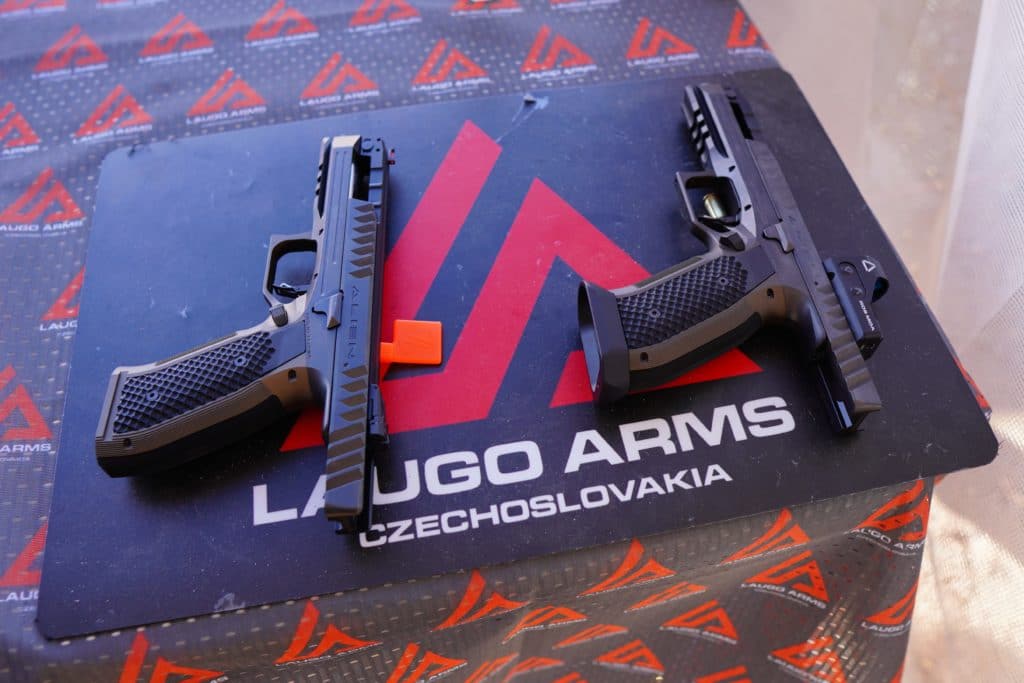
I mean, I only got to fire a dozen shots or so through it. But, I was able to stay on target better with quick follow-up shots than with other handguns I’ve shot.
I’m not sure I’m going to drop $4,000 on one just from that limited experience, though. I don’t know if the difference is worth quite that much. Hopefully, the price will come down, and we’ll see some of the features make their way into other guns too.
Overall, I think the show was a success. I didn’t get sick. I got to shoot some new and exciting guns, connect with people I haven’t seen in years, and try the delicious trash can nachos at Guy Fieri’s restaurant.
So, yea, not bad.
Podcast: Recapping the World’s Largest Gun Show With Outdoor Writer Gabby Hoffman [Member Early Access]
By Stephen Gutowski
SHOT Show is back after being canceled last year due to the coronavirus pandemic.
I was able to attend the show and so was this week’s guest Gabby Hoffman. Gabby has been one of the top outdoor writers in the country for quite some time. She also hosts the District of Conservation Podcast where I’ve been a guest several times.
Gabby and I compare how attendance at this year’s show stacks up to years past, some of the covid mitigation efforts, and how a number of large companies dropping out affected everything. It was certainly a different experience than in years past, but it seemed fairly successful overall. The crowds weren’t back to the level they used to be, but they weren’t small either.
The understandable absence of some larger gun companies may have provided more of an opportunity for smaller companies to entice buyers. This is especially likely since there weren’t many noticeable trends in the industry beyond the introduction of the new .30 super carry caliber. So, buyers looking to find stock two years into the pandemic may be willing to entertain offers from anybody with product. Companies like Sig, Springfield, and Berretta who decided not to attend, probably don’t need the show to make sales while their smaller competitors may be more reliant on the exposure the show offers to grow their sales.
But, industry dynamics weren’t the only thing on display at SHOT. Politics also made their way in. Gabby describes what she saw at the Governor’s Forum where a collection of six Republican governors gathered to describe their approach to bringing in new gun companies. She said they each made their case to the industry that their state would do the most to incentivize and protect gun makers who relocated to their respective states, a big recent trend fueled by increasing hostility to the industry in the northeastern states many were founded in.
Plus, contributing writer Jake Fogleman and I talk about the return of “smart gun” prototypes with one even ending up at the show. And, he explains new details that emerged this week showing Dominion Energy was more connected to the shadowy PAC that tried to suppress gun voters in last year’s Virginia election.
You can listen to the show on your favorite podcasting app or by clicking here.
You can also watch the video podcast on our YouTube Channel.
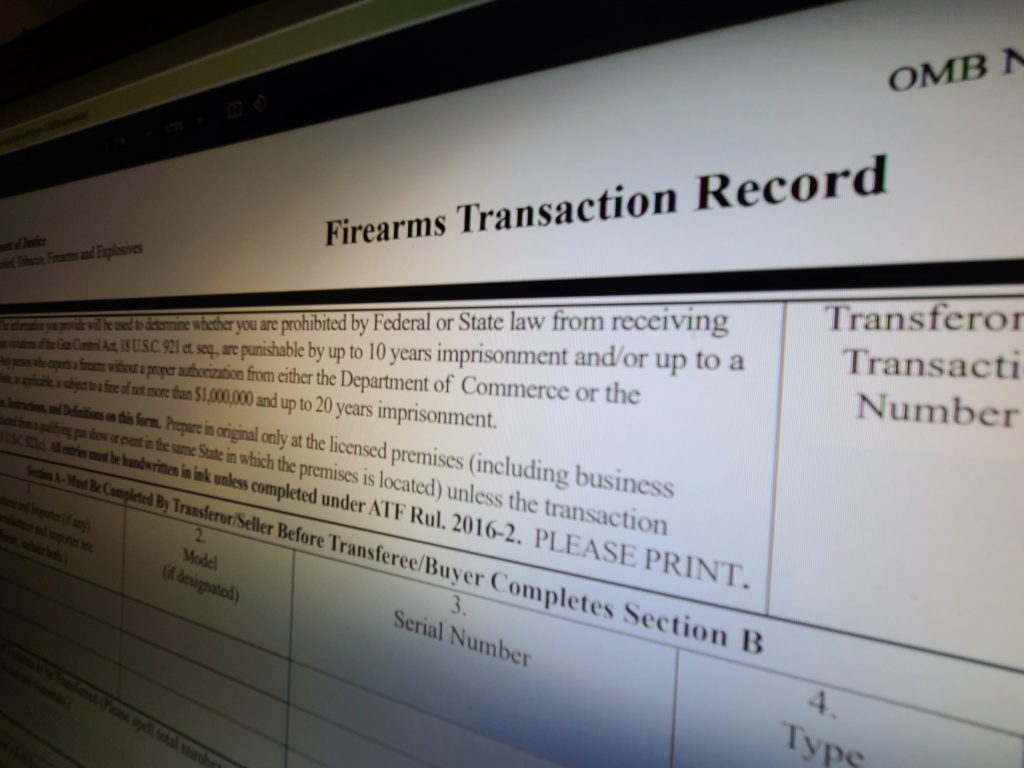
Federal Judge Denies Effort to Block California from Sharing Gun Owners’ Personal Information
By Jake Fogleman
California gun-rights advocates were dealt a setback in federal court on Wednesday.
U.S. District Judge Larry Alan Burns denied a request from gun owners for a temporary restraining order to block the recently signed state law allowing their personal information to be shared with academic research centers. In his ruling, Burns determined that the gun owners had not shown the law created sufficient harm to warrant an emergency restraining order.
The ruling is a blow to the privacy concerns of gun owners throughout the state. As a result, California officials can continue freely sharing gun owners’ personal information while the legal challenge to the law continues to be fought in court. In his brief responding to the effort to block the law, Attorney General Rob Bonta (D.) confirmed that data was already being shared with multiple universities, including the University of California and Stanford.
AB 173, signed by Governor Gavin Newsom (D.) last September, amended portions of California’s gun laws to direct the Attorney General to disclose personal information on gun purchasers to the California Firearm Violence Research Center at UC Davis. The information includes details such as the buyer’s name, address, date of birth, what they purchased, when and where they bought it, and more. It also authorized the center to share the information with any other “bona fide research institution.”
Gun rights groups immediately decried the law, and its passage prompted a lawsuit from the NRA challenging its legality.
“The United States Constitution, the California Constitution, and California statutory law protect Plaintiffs’ right to privacy in the Personal Information that they provided to the Cal DOJ as a condition to Plaintiffs’ lawful exercise of their Second Amendment rights,” the group said in the suit. “Plaintiffs disclosed their Personal Information in reliance on the government’s assurance that their information would be used only for law enforcement purposes.”
In a statement on the suit, NRA-ILA Executive Director Jason Ouimet questioned the security of gun owners’ data in the hands of research institutions.
“This information is a person’s identity,” he said. “And it’s being handed over to organizations that have no duty to safeguard it. This will do nothing to prevent crime — it will only serve to put law-abiding gun owners at risk.”
A spokesperson for the Attorney General’s office previously told The Reload that the AG was undeterred by the legal challenge to AB 173.
“The Attorney General will continue to enforce and defend the state’s laws, including AB 173, and its provisions that seek to improve public safety by providing research institutions with the data they need to study gun violence in order to help us prevent it,” the office said.
Proceedings in the suit against the law will next be held at a preliminary injunction hearing scheduled for March 8.
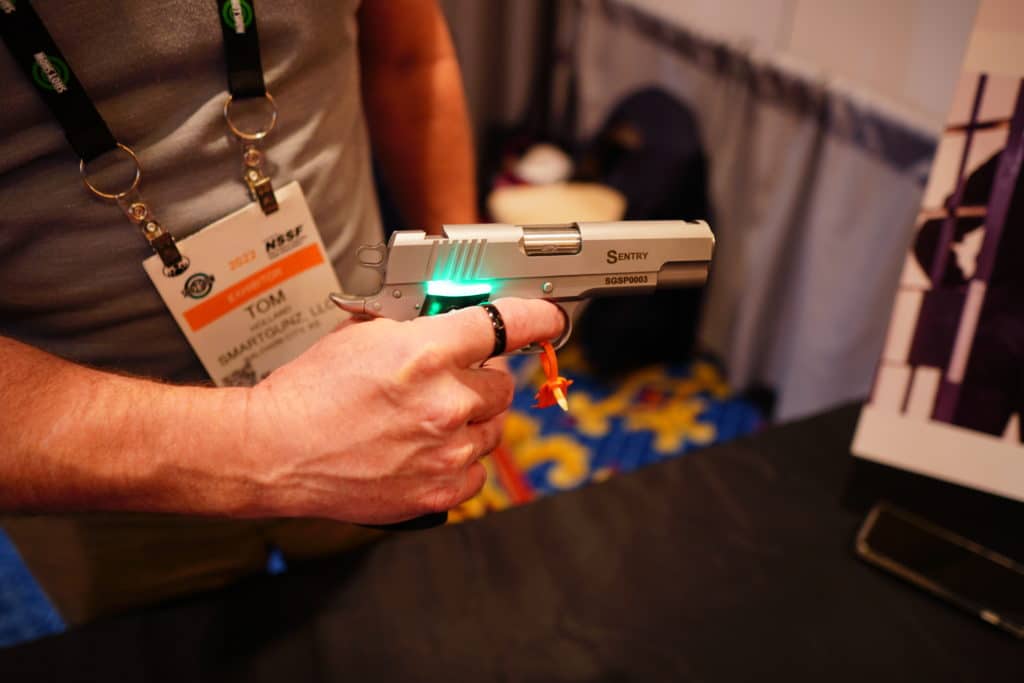
Analysis: Why Proponents of New ‘Smart Guns’ Must Tread Lightly to Gain Gun-Owner Support [Member’s Exclusive]
By Jake Fogleman
Following a Reuters report touting “Smart guns finally arriving in U.S., seeking to shake up firearms market,” media coverage has exploded over the potential for new handgun prototypes to finally make ‘smart gun’ technology viable in the U.S. firearms market. But the history of the technology shows that its boosters will have to tread lightly if they want to make inroads with the gun community.
What is a ‘Smart Gun?’
The term ‘smart gun’ is generally used to refer to a firearm that restricts who can operate it by some method of individual authorization. The technology typically relies on one or more technologies to accomplish this, including magnets, radio-frequency identification, or fingerprint recognition.
Proponents of the concept see it as a way to ensure lost or stolen firearms cannot be used in crime or deadly accidents. Detractors have traditionally questioned the reliability and demand for such technology and see its promotion as a step toward governments mandating their sale in lieu of traditional firearms.
The History of ‘Smart Guns’ in the U.S.
The history of attempts to introduce ‘smart’ technology has been fraught with reliability issues and backlash toward looming government mandates.
In 2000, Smith & Wesson entered into an agreement with the Clinton Administration—in large part to avoid the liability lawsuits that plagued gun manufacturers before the passage of the PLCAA. The agreement stipulated that two percent of the company’s revenue would be dedicated to developing smart gun technology. It also mandated that the “technology will be included in all new firearm models within 36 months.”
As a result, gun owners engaged in a boycott against Smith & Wesson that nearly put the company out of business. That ended its “smart gun” efforts.
Just two years later, the state of New Jersey passed a law that added to concerns over ‘smart gun’ mandates. The Childproof Handgun Law of 2002 made it so that once ‘smart handgun’ technology became available anywhere in the U.S., no other new handgun would be legal to sell in the state.
The law has since been repealed and replaced with a 2019 law requiring all gun stores to sell and advertise ‘smart guns’ once they become available and approved by the state’s Attorney General. Though it is no longer the law, the 2002 law’s legacy still fuels mistrust among gun owners who worry that it could be repeated in other jurisdictions should ‘smart guns’ become widely available.
The Latest Models
The latest “smart gun” offerings come from the companies LodeStar Works and Smartgunz. Both claim to be coming to market this year.
Smartgunz showed off its modified 1911 pistol at SHOT Show, the gun industry’s trade show, this week. It relies on an internal lock opened by a ring that emits a specific radio frequency, according to a report from The Reload’s own Stephen Gutowski. The mechanism is powered by rechargeable batteries kept in the ammunition magazine’s baseplate.
According to Reuters, LodeStar’s handgun functions with an “integrated fingerprint reader and a near-field communication chip activated by a phone app, plus a PIN pad.” It said if the fingerprint scanner failed, the PIN pad would serve as a backup measure.
“The fingerprint reader unlocks the gun in microseconds, but since it may not work when wet or in other adverse conditions, the PIN pad is there as a backup,” the article said. “LodeStar did not demonstrate the near-field communication signal, but it would act as a secondary backup, enabling the gun as quickly as users can open the app on their phones.”
Early signs point to continued issues for “smart guns” when it comes to reliability.
Video of a LodeStar event last week raised questions. During a two-round live-fire demonstration, the pistol appears to malfunction preventing the second shot. The Smartgunz prototype available at SHOT Show was not functional and the company has not done a public demonstration at this point.
LodeStar acknowledges the fallibility of fingerprint technology, but a PIN pad is a less-than-optimal backup in a scenario in which an immediately functioning firearm is a necessity, such as in a defensive encounter. The same principle applies when requiring users to open a phone app in order to make the gun work.
Though, there may be lower-stake scenarios where guns integrated with smart locks could interest some consumers. After all, safes integrating similar biometric or radio-frequency-based technology have been available on the open market for years. They feature many of the same shortcomings but some people still buy them.
The new batch of “smart gun” companies have at least made public statements against mandates as well. Smartgunz co-founder Tom Holland told The Reload the New Jersey law was “disastrous” and his company opposed mandates.
“Our gun is presented as another option,” Holland said. “That’s all it is.”
LodeStar co-founder Gareth Glaser told Tech Xplore they “would really rather the government stay out of it and allow the consumer to make the choice.”
Still, “smart gun” makers should tread lightly as they begin to enter the market. Boosters in the media and advocacy circles should temper their expectations as well.
Until there’s definitive proof that the technology can compete with current firearms in terms of convenience, price point, and reliability, don’t expect widespread take-up among gun owners. And any attempt to mandate their ownership will only serve to sow distrust and galvanize further opposition to the technology.
That’s it for now.
I’ll talk to you all again soon.
Thanks,
Stephen Gutowski
Founder
The Reload




